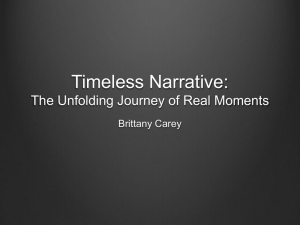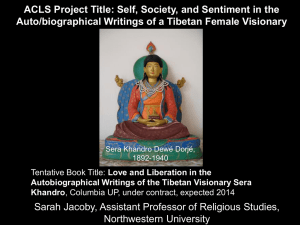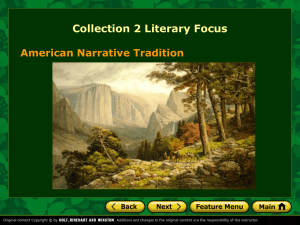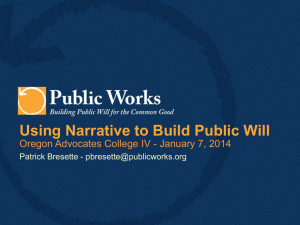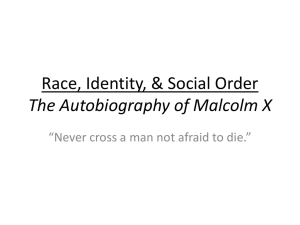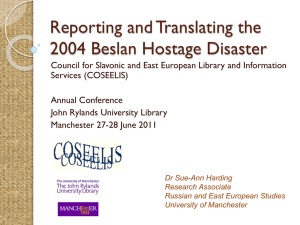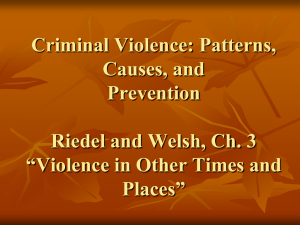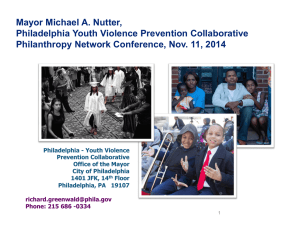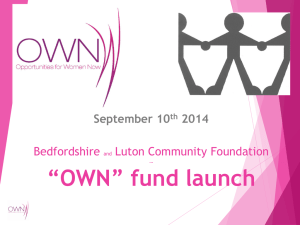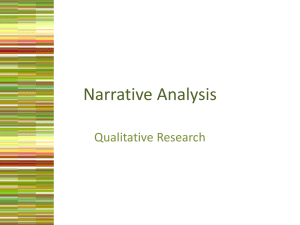Seminar 1 (slides)
advertisement
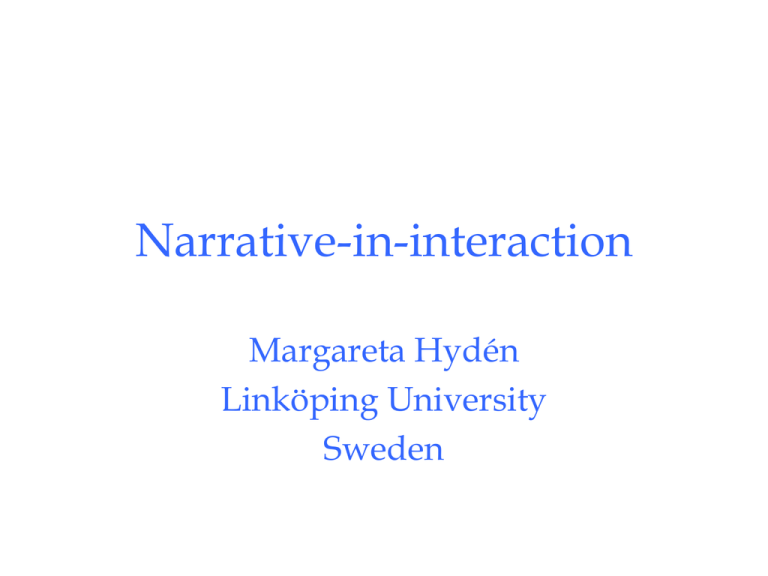
Narrative-in-interaction Margareta Hydén Linköping University Sweden My way to narrative studies • Interviews with 20 couples – 20 men who had been violent on several occasions and 20 women who had been victims of their violence • Interviewed them every 3rd month for two years, started immediately after the the men been reported to the police • 141 interviews Warning !!!!! My way to narrative studies • Collected shorter (women) or longer (men) accounts of how it all started, • about the violent incident (women), • about the after-math (women and men • Tried to analyse the ”data” using grounded theory – found that I ”killed the data” My way to narrative studies • Elliot Mishler, Harvard Medical School • Catherine Kohler Riessman, Boston University • Centre for Narrative Research, UEL Narrative-in-interaction in the context of interpersonal violence The twentieth century will be remembered as a century marked by violence. It burdens us with its legacy of mass destruction, of violence inflicted on a scale never seen and never possible before in human history. Less visible, but even more widespread, is the legacy of day-to-day, individual suffering. It is the pain of children who are abused by people who should protect them, women injured or humiliated by violent partners, elderly persons maltreated by their caregivers, youths who are bullied by other youths, and people of all ages who inflict violence on themselves. This suffering – and there are many more examples that I could give – is a legacy that reproduces itself, as new generations learn from the violence of generations past, as victims learn from victimizers, and as the social conditions that nurture violence are allowed to continue. No country, no city, no community is immune. But neither are we powerless against it. • Many who live with violence day in and day out assume that it is an intrinsic part of the human condition. But this is not so. Violence can be prevented. Violent cultures can be turned around. In my own country and around the world, we have shining examples of how violence has been countered. Governments, communities and individuals can make a difference”. • Nelson Mandela 2002 Narrative-in-interaction Responses to Interpersonal Violence Narrative-in-interaction RIV research focuses: not on causation, not on the linear between cause and effect not on the ethology of interpersonal violence BUT on the circular, i.e. on the responses to interpersonal violence • on interpersonal violence as socially situated • • • • • • Narrative-in-interaction • RIV research focuses on • the relation between response as lived experience and response as known subjectivity, i.e. the dialogue between world/body and word/mind/knowledge • The study of response accounts (narratives, reports etc.) constitutes a way of approaching this relation • (1) Narrative-in-interaction refers to the study of this relation • RIV research seeks to grasp human behaviour, violence in close relationships, through the study of responses and the use humans make of language for telling about the responses Narrative-in-interaction • (2) The concept ”narrative-in-interaction” hints that there is more than one narrative in the air – and the one must find a way to deal with this. • It is not the first time this is mentioned: Narrative-in-interaction ”Innombrable sont les récit du monde” Roland Barthes ”The word in language is half someone else’s. It becomes ’one’s own’ only when the speaker populates it with his own intention, his own accent, when he appropriates the word, adopting his own semantic and expressive intention…. It is from there one must take the word and make it one’s own.” Mikhail Bakhtin (dialogism) Narrative-in-interaction • Conversation Analysis is an approach to the study of natural conversations • Discourse analysis the use of spoken or written language in a social context. • Counter-narratives offer resistance to dominant cultural narratives To set the stage for story telling about social responses to domestic violence – and be prepared to listen to more than one story: The personal social network map • 1) The personal social network map provides a set of potential actors/protagonists in the response drama as a lived experience • 2) The personal social network map provides a point of departure/framework for tellings (knowing) about the response drama The responses to violence as storied social responses • 40 women interviewed from city, small town and rural settings • No direct observation but some ethnographic data collected Narrative-in -interaction • (3) Narratives-in-interaction may form a main narrative (ground) and backing or conflicting narratives (figure) • (4) Narratives-in-interaction may form a hierarchical or a same level organization Main, backing & conflicting narratives/storylines Backing & conflicting narratives/storylines are narratives in there own right, but with special qualities and capacities in relation to the main narrative A backing narrative/storyline strengthens the main narrative A conflicting narrative/storyline weakens the main story The storied nature of social responses to interpersonal violence: Betty’s story • Main narrative: “Domestic violence is not OK” • Backing family narrative: “Violence in families is not OK but it may happen and it must be controlled”. • Backing social network/family narrative: “We are family. Families are for support and order”. • Backing social network/family narrative: “The men in the family must take action in order to control the violence and support the victims”. • Backing storyline (Betty’s): “I am there for them, they are there for me”. • Backing social network/coworkers storyline: “Violence in families are not OK but it may happen and it must be controlled and the victims supported” • Protagonists: Family, friends and coworkers The storied nature of social responses to interpersonal violence: The conflicting (opposing) narrative • Main narrative: “Domestic violence is not OK” • The conflicting narrative is a ”but” – narrative The power of backing narratives • Conclusion: • There is a need for analysing not only the main but also the backing narratives • Never underestimate the power of the backing narratives The storied nature of social responses to interpersonal violence: Anna’s story • Main narrative: ”Domestic violence is not OK” • Main family (mother &sisters) narrative: ”Violence is not OK and it doesn’t happen in our family.” • Backing family (mother & sisters) narrative: “We are the role-model for many families in town and we want it to stay this way.” • Backing family (mother & sisters) narrative: “Father may not be disturbed” • Conflicting (Anna’s) narrative: “We are family and I need their help. This is what families are for”. • • Protagonists: Mother & sisters Missing protagonists: Father, colleagues Suggestions Strong norms (main narrative) against family violence are not enough to stop the violence (?) A backing family narrative and backing social network narratives need to be added (?) Conflicting narratives may oppose the backing narratives without opposing the main narrative or the backing family narrative (?). More narrative research is needed Suggestions/Conclusions • ”Narratives are identity performances. We express, display, make claims for who we are – and who we would like to be – in the stories we tell and how we tell them. In sum, we perform our identities.” Elliot Mishler (1999) Storylines. Craft Artists’ Narratives of Identity Narrative as identity performances: Anna, the excluded, Betty, the included. Narrative-in -interaction • Finally some words about a work in progress: • Mothers and teenage sons talking about violence in close relationships: • Victims´ and Bodyguards 'narratives in interaction • Margareta Hydén & David Gadd: ”Bodyguards with and without a mission”

